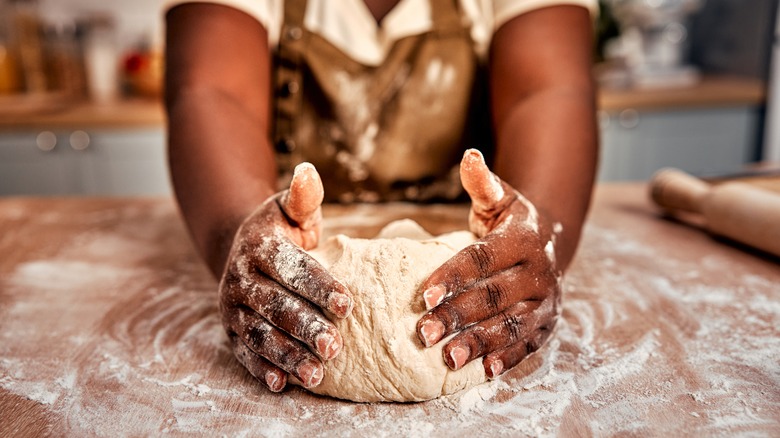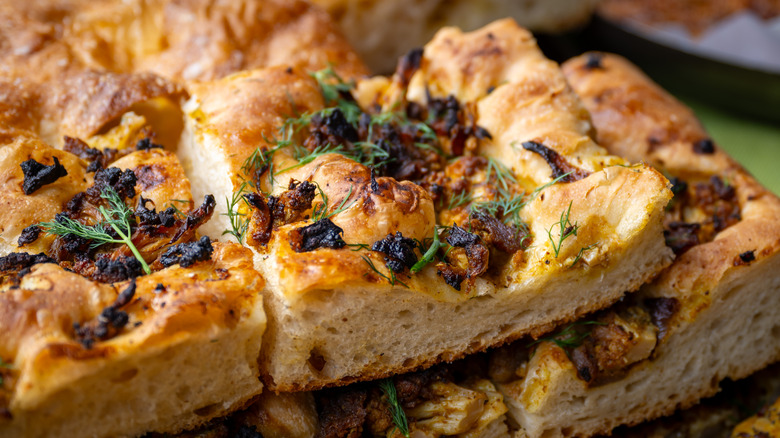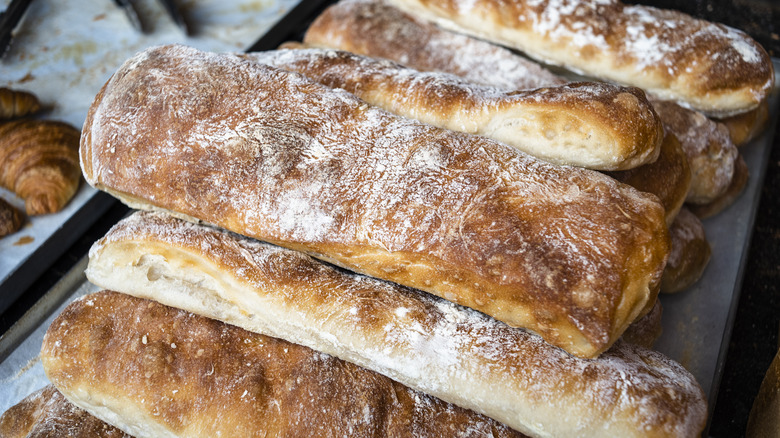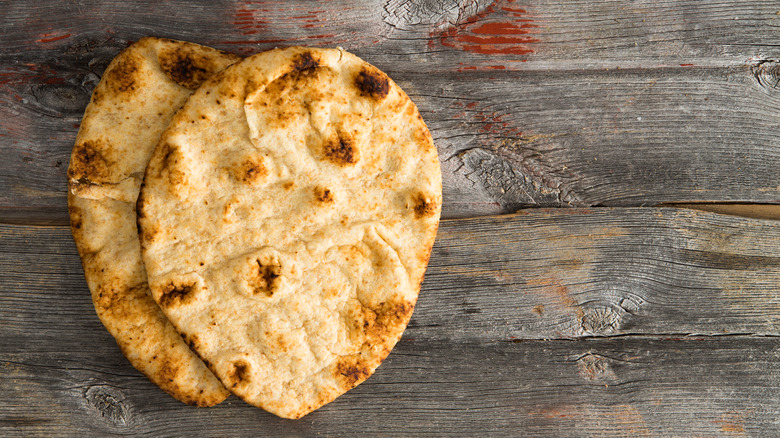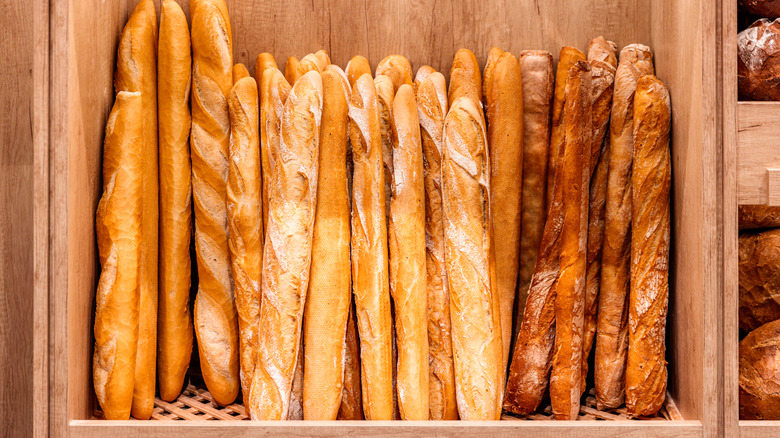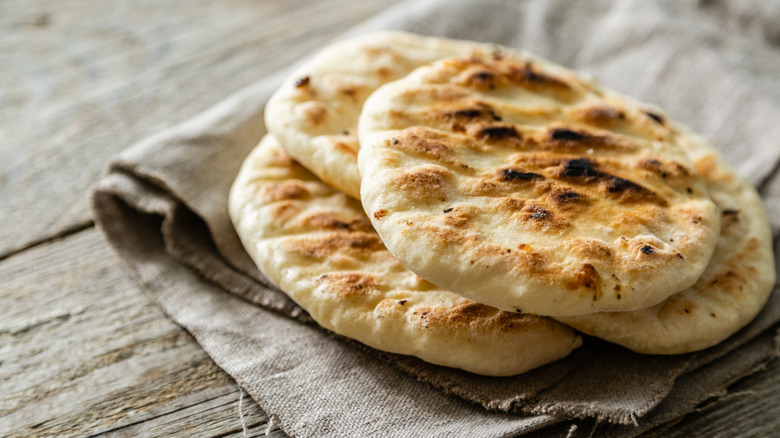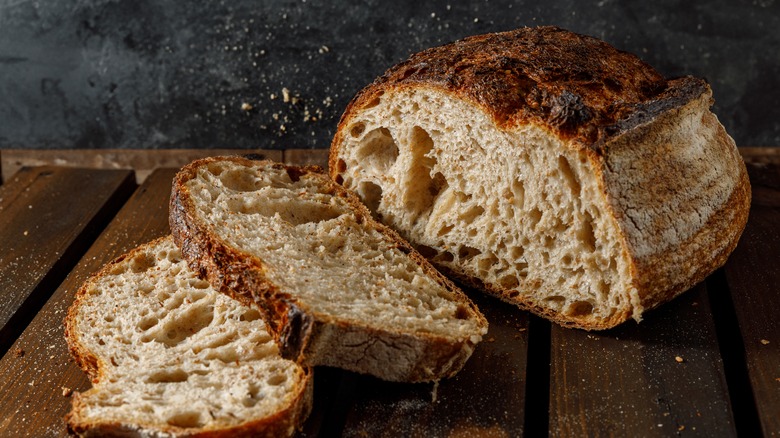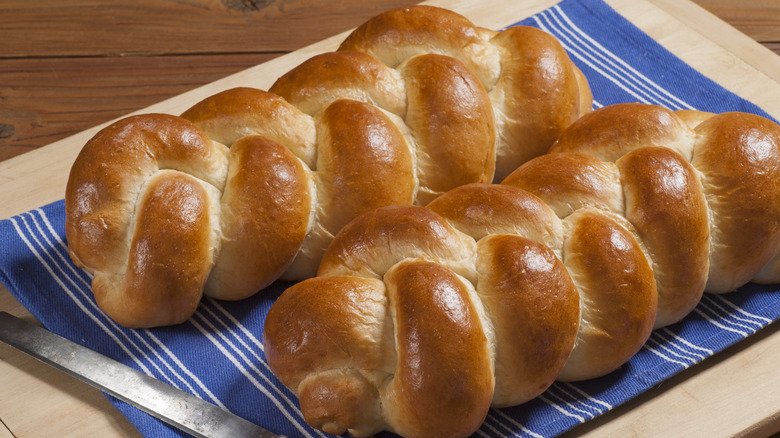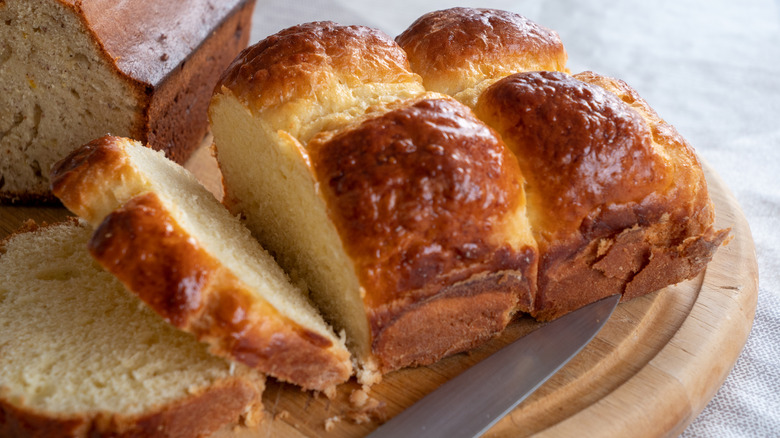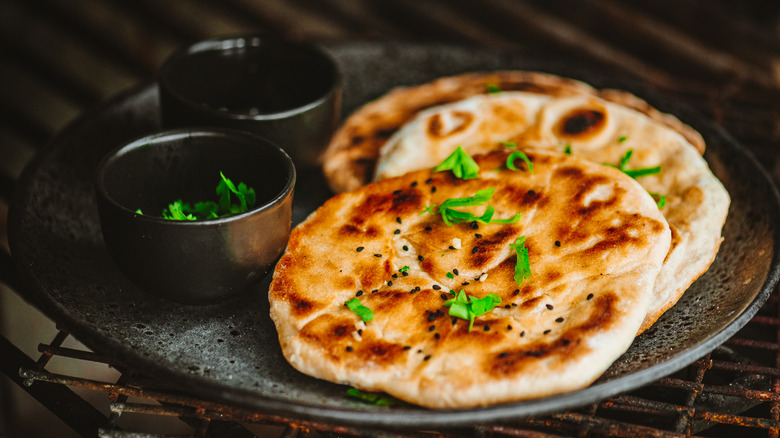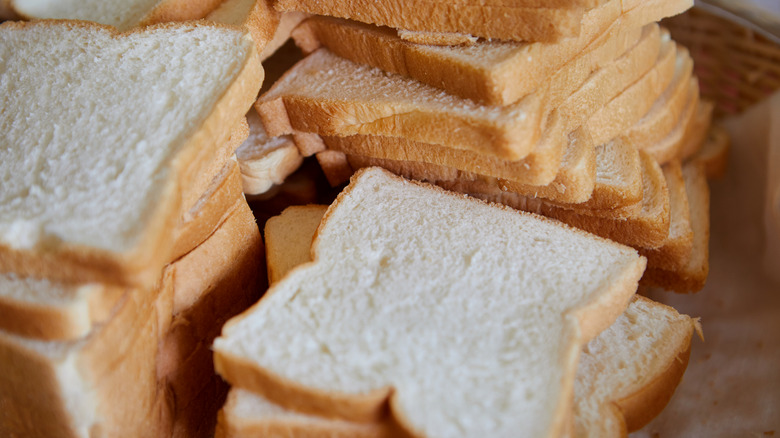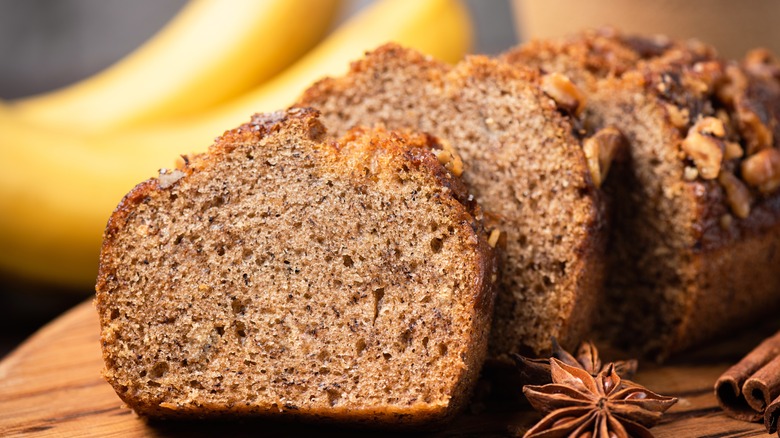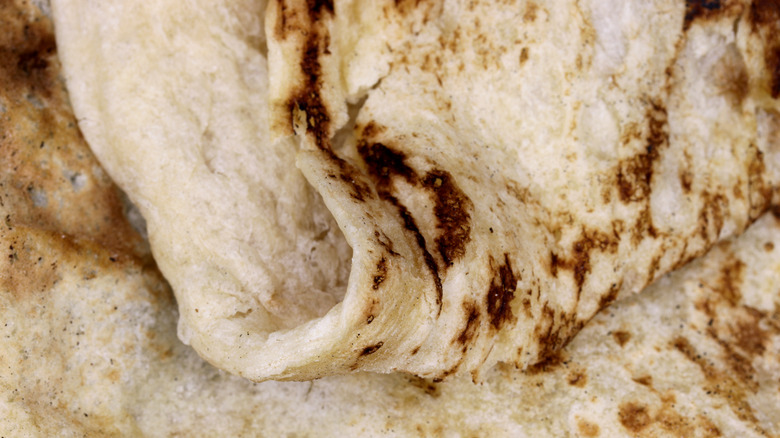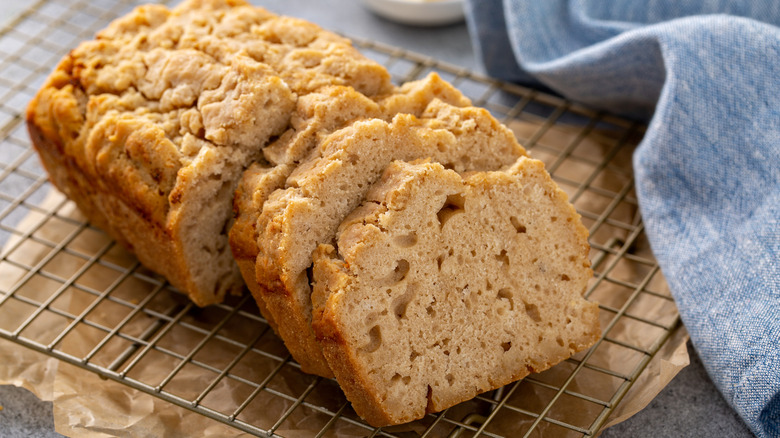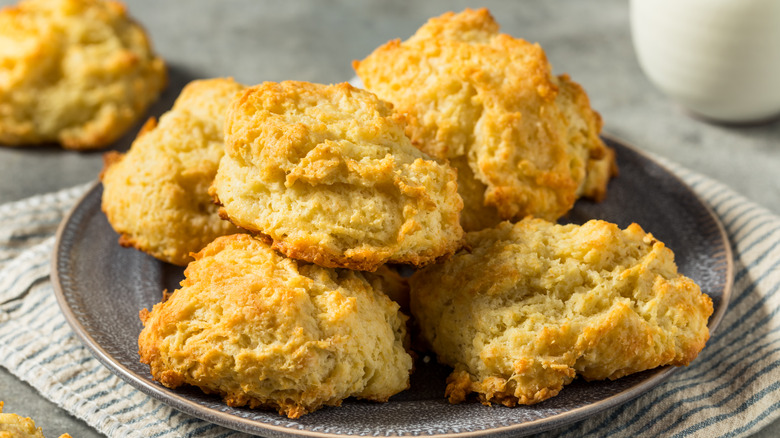14 Types Of Breads To Make That Are Perfect For Beginning Bakers
We may receive a commission on purchases made from links.
For many home cooks, the idea of baking bread from scratch can feel overwhelming. Unless you're one of the many who took a deep dive into making sourdough during the pandemic, the process may seem complex. Fortunately, not all breads are created equal — some are far more approachable than others. If you're a novice baker, it's practical to begin with simpler varieties before tackling more advanced techniques. There are many reasons why making homemade bread is good for you – aside from its outstanding flavors, it can transform an ordinary meal into something exceptional, providing a sense of accomplishment that's hard to beat.
To help demystify the process, we spoke to professional bakers, gathering their insights on the most accessible styles of bread for beginners. Their advice helped us identify three broad bread categories that are ideal starting points: no-knead breads, flatbreads, and quick breads. Each of these skips a traditionally time-consuming or technically demanding step, like kneading, proofing, or dealing with yeast. Whether you're looking for a cozy weekend project or simply hoping to elevate your everyday meals, these recipes offer a satisfying and stress-free entry into the world of bread baking.
Focaccia
The holy grail of easy breads, focaccia is widely regarded as one of the most accessible breads to make at home. Its crisp crust and airy, tender interior often belie the minimal effort required to achieve such results. Kara Blitz, executive pastry chef at Lincoln Ristorante, points to focaccia as a smart starting point for beginners. It boasts a straightforward process, forgiving dough, and endless potential for customization. "Flatbread and focaccia are some of the oldest bread recipes," Blitz says. "I think they require basic technique, but are ultimately straightforward processes."
Unlike more meticulous breads that depend on precise measurements and special ingredients, focaccia invites flexibility and experimentation. At its core, focaccia is a high-hydration dough composed of flour, active dry yeast, warm water, salt, and a touch of sugar or honey. It should also be generously soaked in olive oil. These ingredients come together to yield a sticky, supple dough that typically requires no kneading (just gentle folding) and can often be prepared and baked in a single day. Prior to baking, the surface is dimpled with fingertips, forming characteristic pockets that catch oil and seasonings. Traditionalists may opt for a draping of mortadella or prosciutto. In recent years, social media has sparked a wave of edible artistry, with bakers crafting floral patterns and whimsical vegetable landscapes – though, in true Italian fashion, such embellishments may draw the occasional side-eye.
No-Knead Ciabatta
Translating to "slipper" in Italian – a nod to its long, flat shape — ciabatta is prized for its crisp crust and irregular, webbed structure. With a rustic appearance and light dusting of flour, ciabatta is a staple in sandwich making, but it also shines on its own. Traditionally, ciabatta is made with a "biga," a type of pre-ferment common in Italian baking, and requires gentle folding to develop its notoriously airy texture. "Don't start with sourdough or other pre-ferments," advises Giorgia Caporuscio, Master Pizzaola and owner of Don Antonio in NYC. "Beginners can start easily with a ciabatta bread or also something similar to a baguette ... There are also some no-knead versions of those."
No-knead ciabatta skips the biga and instead relies on time, specifically a long, slow fermentation overnight, to naturally develop gluten. "Take your time and be patient," adds Louis Kim, owner of 123Dough. "Let the dough rest and rise fully. Also, weigh your ingredients — it's more accurate than using cups." Once shaped into its signature form, the dough proofs before baking, yielding an open crumb and crisp, golden crust. The result is a loaf that feels impressive but surprisingly approachable — perfect for anyone looking to level up their baking with minimal fuss.
Flatbread
True to its name, flatbread is defined by simplicity, both in shape and preparation. According to Kara Blitz, a generic flatbread is a good place to start for beginners. Unlike other loaves that require careful shaping, long fermentation, and precise proofing, many flatbreads come together quickly and easily. Some recipes don't have any rise time at all, thanks to their thinness.
Considered a type of "lean dough," flatbread is made with only the essentials: flour, water, salt, and sometimes yeast or another leavening agent. Certain versions call for only so many ingredients, especially when self-rising flour comes into play, like in a two-ingredient flatbread. "On the other side of the bread spectrum from enriched doughs are 'Lean Doughs,' which can be more particular/exacting in the bread's needs for exact ratio/scaling of the ingredients," says Blitz. Still, that doesn't necessarily mean lean breads are difficult to make. On the contrary, flatbreads offer a forgiving format to explore texture, flavor, and technique. From stove-top skillet breads to oven-baked rounds, flatbreads are a great entry point to developing foundational skills without the intimidation of dealing with a full rise.
No-Knead Baguette
Arguably the crème de la crème of crusty breads, the baguette can be one of the more daunting styles to tackle. Maybe it's the French pedigree — or maybe it just sounds fancier than it actually is. But with a no-knead method, it becomes far more approachable. "For beginners (and bakers of all levels, really), I love a no-knead recipe," says Anna Gordon. With baguettes, structure and crust come from proper fermentation, shaping, and baking with steam. The dough is a high-hydration one, shaped into slender batons before being scored and baked on a stone.
No-knead baguettes rely more on time than technique, allowing the dough to develop structure through extended fermentation. It's a hands-off approach, but not a mindless one. "Remember that recipes are guidelines, not gospel," says Kara Blitz. "Especially with yeasted doughs, consider the environment in which you are baking. On hot and humid days, the yeast will be more active and vice versa." Like any great bread, a baguette rewards patience, observation, and a bit of humility. "It is such an ancient discipline requiring patience and practice," Blitz adds. "But, still that first bite of a freshly baked loaf makes it all worthwhile."
Pita
Known for its characteristic pocket ready to be stuffed with any combination of fillings, pita dough is relatively straightforward and doesn't require complicated shaping. Homemade pita offers a noticeably softer texture and deeper, yeasty, nuttier flavor compared to store-bought versions. It will instantly elevate anything from a classic falafel to the ultimate grilled cheese. The magic of pita lies in the way it swells dramatically into a balloon during baking. A well-hydrated dough traps steam as it heats up, creating its signature hollow center.
Bakers just starting out will appreciate that pita dough doesn't require much kneading, especially when instant yeast is used to speed up the process — and there's no shame in using it. In fact, plenty of professionals rely on it at home. "I think it's a matter of what you have access to," says Anna Gordon. "I use SAF-Instant Dry Yeast for my bread baking at home, and it works fantastic." Once the dough has rested, instead of shaping into a loaf, it's rolled out with a rolling pin. Baking the pitas in a super hot oven is key to ensuring that dramatic puffing takes place and the perfect pocket forms. Because pita bread relies more on steam and rolling precision rather than mastering complex skills or special equipment, it's a rewarding introduction to working with yeasted doughs.
No-Knead Artisan Loaf
For those craving a sourdough-esque loaf without the commitment of maintaining a starter, a no-knead artisan bread is another great option. Like the name suggests, this method requires no kneading — a huge win for novice bakers wary of complicated techniques. Made with only four basic ingredients, a simple no-knead bread strips bread-making down to its purest form. While the flavor will be on the mild side (don't expect much tang), an extended resting period allows for a long, slow fermentation, developing a gentle depth of flavor and an airy, open crumb. "If you have a recipe with long fermentation, the dough kind of 'fixes itself' over time," says Giorgia Caporuscio.
The process is fairly hands-off: After combining the ingredients into a shaggy dough, time takes over. An overnight rest develops complexity with minimal effort. "Patience is the secret ingredient for the perfect bread recipe," says Nicola Olivieri. For beginners eager to move beyond basic sandwich loaves but not quite ready to meet the demands of sourdough culture, no-knead bread is the best of both worlds. It's proof — literally — that great bread doesn't have to be complicated.
Challah
Challah is a staple at Jewish celebrations, known for its glossy sheen and beautiful braided form. Enriched with eggs and oil, the dough yields a rich, slightly sweet flavor and a soft, spongy texture. While the process does involve kneading, it doesn't have to feel daunting. "Using a stand mixer with a hook can be helpful," says Anna Gordon, "but I personally love the forearm and core workout of kneading by hand."
Kneading is essential to the process of making many breads. "Kneading builds gluten, which helps the bread rise and hold its shape," explains Louis Kim. "You can stop kneading when the dough stretches without tearing." Once your challah dough is smooth and tacky, it's divided and rolled into ropes, then braided using anywhere between three to six "strands", depending on the baker's flair. A final egg wash lends challah its signature golden, shiny finish. While often enjoyed freshly-sliced or torn at the table, challah's tender crumb also makes it an excellent vehicle for next-day bread pudding or French toast.
Brioche
Now, brioche probably shouldn't be the first bread you ever attempt to make, but it's a natural place to go once you've successfully made some challah. "Brioche is an 'enriched dough,' meaning it has ingredients beyond flour, water, yeast, and salt," explains Kara Blitz. In the case of brioche, milk, eggs, sugar, and butter are incorporated. "These ingredients help not only with flavor, but also create the desired texture without too much extra manipulation."
Despite its occasionally temperamental nature, homemade brioche is still achievable for beginner bakers. The extra fat makes the dough slightly less prone to over-proofing, which could lead to a deflated, uneven, or dense loaf. Be mindful of your kitchen's temperature, too, during proofing. "When [the temperature] is high, it speeds up [proofing], and when it's cold it slows down the process," notes Nicola Olivieri, award-winning pastry chef and fifth-generation baker at Olivieri 1882. Anna Gordon, pastry chef and owner of The Good Batch in Brooklyn, agrees. "A warmer resting environment is really going to help proofing bread. In the summer, bread will proof really quickly, but in the winter, when my kitchen is really cold, I'll turn my oven on low, then stack a couple of trivets on my stovetop to rest my bowl upon." With these tips in mind, even novice bakers can turn out a brioche that is rich, tender, and pillowy in texture.
Naan
South Asian breads are anything but monolithic — but if there's a crown jewel, it might just be naan. The pillowy, blistery flatbread is traditionally cooked in a blazing hot tandoor, giving it its signature char and chew. While most home kitchens lack a tandoor, homemade naan is still absolutely within reach. Unlike many flatbreads, naan is a yeasted dough enriched with yogurt or milk and ghee (aka clarified butter), a ubiquitous ingredient in Indian cuisine. There's no kneading required, and the dough only needs a single rise, then a short rest after being shaped into rounds.
Most naan recipes rely on instant yeast for convenience, but the real key is watching the dough, not the clock. Check your dough often to ensure proper rising without over-proofing. "I prefer working with low temperature and more time," advises Nicola Olivieri. When it's ready, naan cooks beautifully in a hot, well-seasoned cast-iron skillet. A drizzle of oil helps mimic the smoky, blistered surface of the tandoor-baked versions. Variations are endless, but few are as beloved as garlic naan, brushed with a rich garlic butter — a universal favorite.
White Sandwich Bread
Rustic loaves tend to steal the spotlight, but there's something deeply comforting about a nice, plain white bread. Soft, versatile, and beginner-friendly, it's a foundational bake that still offers plenty to master. The dough is typically enriched with fat, which gives it a tender crumb and pliable texture. While it may seem overly simple, white bread is an excellent way to build skill and confidence in the kitchen. It introduces essential techniques like proofing, shaping, and developing gluten structure. "My main tip is keep trying, asking and educating yourself," says Kara Blitz. "Expect a journey. Learn about how to check your gluten window! Learn about protein content of the different flour types."
And while baking, by nature, is a precise science, there's room to experiment thoughtfully with white bread. "When tweaking a recipe, only change one thing at a time," Blitz says. "Rule of thumb if you want to adjust anything is start with 10% — it's enough to see a change, but not completely alter the structure." Consider different types of flour, for example (white versus whole wheat) or fat sources (butter versus shortening). It may be a humble loaf, but white bread is deeply satisfying, nostalgic, and adaptable.
Banana bread
Soft, moist, and just sweet enough, banana bread may blur the lines of what counts as "bread," but it fits the definition, and few would argue with its appeal. Technically a quickbread, banana bread omits the yeast and instead rises with baking powder/soda, making it one of the easiest kinds to tackle. The base, unsurprisingly, is bananas. Ideally, they're overripe and heavily speckled, which indicates more sugar and moisture to yield a smoother, sweet batter.
Even in its most basic form, banana bread is profoundly satisfying. But for a quick and easy banana bread, consider utilizing a boxed vanilla cake mix to stand in for the dry ingredients and leavening agents. It's nearly foolproof, and still allows room to tinker. Add-ins like chopped walnuts offer crunch, while chocolate chips add pockets of richness. Whether you call it bread, cake, or something in between, banana bread delivers comfort in the form of a loaf.
Lavash
An ancient Middle Eastern flatbread, lavash is at its best when soft and flexible. Traditionally, it's baked against the walls of a clay oven called a "tonir," which is deeply rooted in regional culinary history. With basic pantry staples and a hot skillet, fresh lavash is entirely doable at home. Some versions skip yeast altogether, yielding an ultra-thin, cracker-like texture, while others swap in milk for water to create a more supple, tender bread. Either way, as with all breads, homemade is always better than store-bought. "[Homemade bread] smells amazing, tastes better, and gives you a great feeling of making something with your own hands," says Louis Kim. "It's very satisfying."
The dough comes together easily and should be slightly sticky, but that can be mitigated by using enough olive oil. It rises for a short time, about 45 minutes, before being rolled into thin discs. The discs are then cooked in a hot skillet for around 30 to 40 seconds, until bubbles form and golden brown spots appear. Tremendously versatile, lavash is ideal for scooping up Mediterranean staples like hummus, baba ganoush, and labneh. It can also double as a wrap or edible plate for falafel, grilled meats, and vegetables. As it soaks up every last bit of sauce and juice, it offers up a final, flavor-packed bite at the end of your meal.
Beer bread
Beer might not be the first ingredient that comes to mind when baking bread, but it's a surprisingly effective leavening agent. Thanks to its natural carbonation and yeast content, beer helps to create a loaf that's hearty, malty, and incredibly easy to pull off. For a successful beer bread, the base's ingredients are simple: flour, baking powder, salt, and butter, plus one bottle of your finest brew on hand. From there, you can tweak the flavor with a spoonful of spicy mustard, fresh herbs, or savory mix-ins like caramelized onions, sharp cheddar, or roasted garlic for a subtle bite.
The type of beer you use makes a difference. A light lager will do the job, but might not contribute much in the flavor department. A juicy citrus pale ale can add sweet, hoppy notes, while a dark stout lends depth and richness. So the next time you're in a baking mood but fresh out of yeast, crack open a cold one to bake with (and one to drink while you're at it).
Drop biscuits
The idea of making biscuits from scratch can scare off beginner home bakers, but there's no reason to fear. Drop biscuits are an easy, approachable alternative. Unlike classic cut biscuits, which require rolling, shaping, and sometimes laminating, drop biscuits rely on a wetter, looser dough (closer to a thick batter) that's simply scooped and "dropped" on the baking sheet — no kneading needed.
Their rugged, craggy appearance creates crispy peaks and soft valleys, while the interior stays fluffy and tender. You won't get the distinct flaky layers of a rolled biscuit, but these are still quick, easy, and satisfying to make. Ready in under 30 minutes, drop biscuits are a go-to for spontaneous baking, last-minute guests, or sudden cravings. And like any good baked item, there's joy in watching them come to life.
